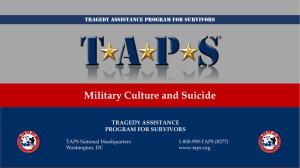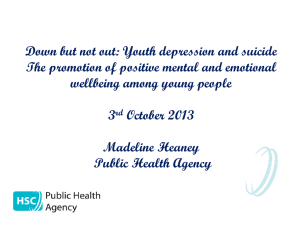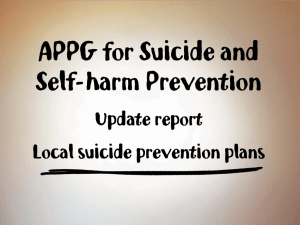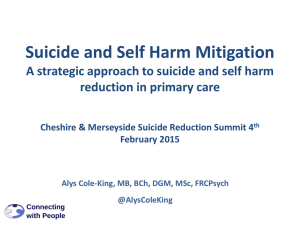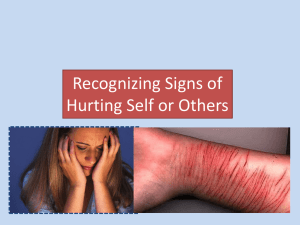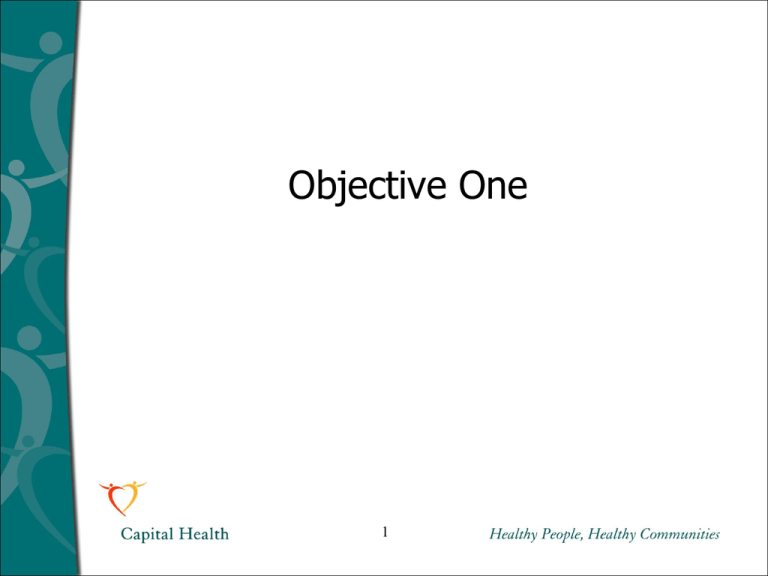
Objective One
1
Assessment of Suicide Risk For
Health Providers in Nova Scotia
Created by: Dr. Stan Kutcher
Sun Life Financial Chair in Adolescent Mental
Health
Director, WHO Collaborating Center
IWK and Dalhousie University
And
Dr. Joseph Sadek
Chair of the CDHA Task Force for Suicide
August 2012
Purpose and Information
1. This is a self-teaching course for to help you upgrade your
skills in identification and risk assessment regarding
suicide.
2. It is intended for non mental health professionals.
3. It will take approximately a half hour to forty-five minutes
of your time.
4. Upon course completion there is a short quiz that should
be answered. Correct answers to all the questions will
result in verification that you have successfully completed
this skills upgrade.
5. Thanks for taking the time to do this.
3
Thanks to the following for
review of content
• Dr. Sonia Chehil: Department of Psychiatry IWK
• Kim Hiscock: BN, RN, CPRP, Clinical Nurse
Educator, Capital District Health Authority
• Susan Charlton: Faculty RN: PDC; CDHA
• Dr. Ian Slayter: Department of Psychiatry CDHA
4
What is Suicide?
• Suicide is the considered taking of one’s own
life
• Suicide is a behavior, it is not a mental illness
• The reasons for suicide are complex and multifactorial; there is no one single “cause” of
suicide
• Suicide is a highly emotional topic, for every
person who dies by suicide, many are affected
5
What Suicide is Not
• Suicide is not common: in Nova Scotia suicide
rates are approximately 8/100,000
• Suicide is not an expected response to usual
stresses of life
• Suicide is not the result of personal weakness,
supernatural forces or socioeconomic status
• Suicide is often but not always associated with
the presence of a mental illness
• Suicide is not an epidemic: suicide rates in
Canada have decreased about 30 percent
between 1990 and 2004. Nova Scotia suicide
rates decreased as well.
6
Suicide Related Terms
• Suicidal ideation: thoughts, ruminations, preoccupations about death (particularly selfinflicted)
• Suicidal intent: the considered decision to die by
suicide
• Suicide plan: the specific ideas a person has
about how they will take their life
• Suicide attempt: the considered act of self injury
expected to result in death
7
Suicide and Self-harm
• Not all self-harm episodes are suicide attempts
• They are differentiated by the INTENT of the
self-harming action: self injury that occurs along
with the intent to die is a suicide attempt; self
injury that occurs without the intent to die is
self-harm
• Self-harm may be understood as a
manifestation of poor coping; a behavioral
phenomenon; a symptom of impulsivity;
aberrant self-soothing behavior etc.
• Self-harm may become a chronic condition
associated with personality disorder and/or
substance abuse
8
Suicide is a LOCAL issue
• In Canada the variation in the suicide rate
across provinces/territories is substantial (e.g.:
Quebec about twice that of Nova Scotia)
• Suicide rates in first nations tend to be higher
than Canadian average but vary greatly
amongst different first nation communities
• Health care providers need to know the suicide
rates in their location (for Nova Scotia, the
youth suicide rate is approximately 5 per
100,000 and the overall suicide rate is
approximately 8 per 100,000)
9
Age Adjusted Suicide Rates
selected Canadian Provinces
(2007)
10
Suicide: Age and Sex
• Suicide is rare in children
• Suicide rates rise in the decade post-puberty to
reach “adult” levels around age 25
• Suicide rates rise again around the ages of 35 –
55: and this rise is mostly in males
• Suicide rates are higher for males than for
females across the life-span
• Demographically, the person most at risk for
suicide is a male, ages 35 – 55.
11
Annual Death Rate (with 95% confidence intervals) for
suicide by age group and sex
(1995-2004)
The Nova Scotia report on Suicide in NS – 2009:
http://www.gov.ns.ca/hpp/publications/Suicide_Report.pdf
12
Nova Scotia and Suicide
• Persons who die by suicide in Nova Scotia are
more likely to be: males; have a diagnosis of
mental disorder (often a mood disorder or
substance abuse); known to the mental health
system; have a previous history of a suicide
attempt
• Compared to all those who die by suicide, young
people who die by suicide in Nova Scotia are
less likely to be known to the mental health
system
• Substantial numbers of those who died by
suicide in Nova Scotia had contact with a health
care provider in the months prior to death
13
Substantive Suicide Risk Factors:
RISK
Risk factors are epidemiological co-relates that
increase the probability of a specific outcome. Not all
risk factors are causal and not all risk factors carry
the same weight of probability for a specific outcome.
Suicide risk factors are multiple, complex and of
different weights. They include disease factors (such
as mental illness); genetic factors; psychological
factors; social/environmental factors. In any one
individual it is the combination of these factors that
increase the person’s unique probability for suicide.
14
Substantive Suicide Risk Factors
• Current suicide intent or plan
• Presence of a mental disorder (depression,
substance abuse and Schizophrenia have highest
correlation to suicide but all mental illnesses
significantly increase suicide risk)
• Family history of suicide
• Previous suicide attempt
• Availability of lethal means (eg: guns)
• Withdrawal from family, friends and society
• History of childhood sexual abuse/maltreatment
• Presence of a serious impairing medical illness
15
Other Suicide Risk Factors
•
•
•
•
•
•
Hopelessness
Rage, anger, agitation, impulsivity, seeking revenge
Expressing feelings of being trapped with no way out
Aboriginal ,immigrant, refugee
Recent crisis, conflict or loss
Recent: admission, discharge or multiple recent
emergency department visits
• Assessor concerned
• Collateral info supports suicidal intent
Estimated Lethality of Suicide Methods in NS
(1995-2004)
The Nova Scotia report on Suicide in NS – 2009:
http://www.gov.ns.ca/hpp/publications/Suicide_Report.pdf
17
Frequency of suicide deaths by
sex and method 1995-2004
The Nova Scotia report on Suicide in NS – 2009:
http://www.gov.ns.ca/hpp/publications/Suicide_Report.pdf
18
Suicide Prevention
• We do our best to prevent suicide
• The best evidence for suicide prevention is
identification and appropriate interventions for
those who are at greatest risk
• Training health care providers to recognize,
assess and manage or appropriately triage
individuals at high risk for suicide appears to be
the most effective suicide prevention strategy.
• In Nova Scotia, substantial numbers of people
who die by suicide visit health care providers
prior to the event.
19
Average number of mental health contacts (with
95% confidence intervals) one year prior to
hospitalization for suicide attempt, by rural/urban
status (1995-2004)
The Nova Scotia report on Suicide in NS – 2009:
http://www.gov.ns.ca/hpp/publications/Suicide_Report.pdf
20
End of Objective One
Please continue to Objective Two






